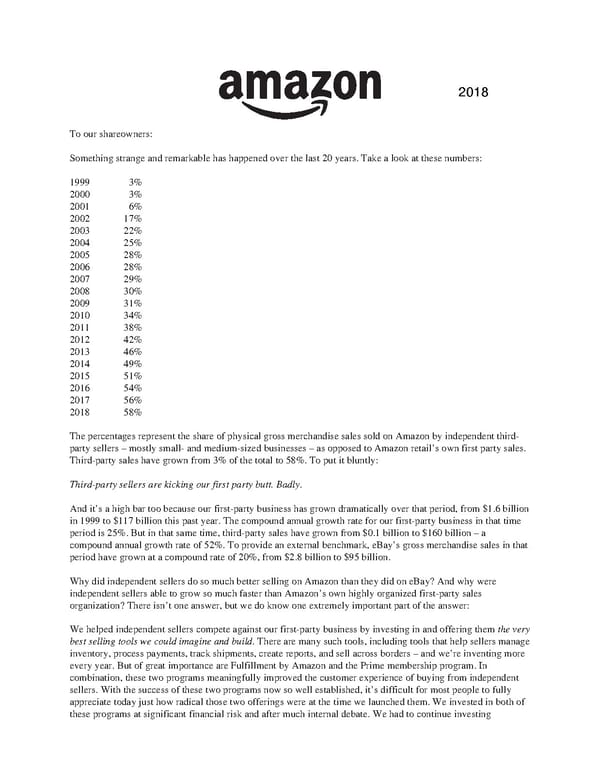2018 Toourshareowners: Something strange and remarkable has happened over the last 20 years. Take a look at these numbers: 1999 3% 2000 3% 2001 6% 2002 17% 2003 22% 2004 25% 2005 28% 2006 28% 2007 29% 2008 30% 2009 31% 2010 34% 2011 38% 2012 42% 2013 46% 2014 49% 2015 51% 2016 54% 2017 56% 2018 58% Thepercentages represent the share of physical gross merchandise sales sold on Amazon by independent third- party sellers – mostly small- and medium-sized businesses – as opposed to Amazon retail’s own first party sales. Third-party sales have grown from 3% of the total to 58%. To put it bluntly: Third-party sellers are kicking our first party butt. Badly. Andit’s a high bar too because our first-party business has grown dramatically over that period, from $1.6 billion in 1999 to $117 billion this past year. The compound annual growth rate for our first-party business in that time period is 25%. But in that same time, third-party sales have grown from $0.1 billion to $160 billion – a compoundannualgrowthrate of 52%. To provide an external benchmark, eBay’s gross merchandise sales in that period have grown at a compound rate of 20%, from $2.8 billion to $95 billion. Whydidindependent sellers do so much better selling on Amazon than they did on eBay? And why were independent sellers able to grow so much faster than Amazon’s own highly organized first-party sales organization? There isn’t one answer, but we do know one extremely important part of the answer: Wehelpedindependent sellers compete against our first-party business by investing in and offering them the very best selling tools we could imagine and build. There are many such tools, including tools that help sellers manage inventory, process payments, track shipments, create reports, and sell across borders – and we’re inventing more every year. But of great importance are Fulfillment by Amazon and the Prime membership program. In combination, these two programs meaningfully improved the customer experience of buying from independent sellers. With the success of these two programs now so well established, it’s difficult for most people to fully appreciate today just how radical those two offerings were at the time we launched them. We invested in both of these programs at significant financial risk and after much internal debate. We had to continue investing
 Amazon Shareholder Letters 1997-2020 Page 94 Page 96
Amazon Shareholder Letters 1997-2020 Page 94 Page 96